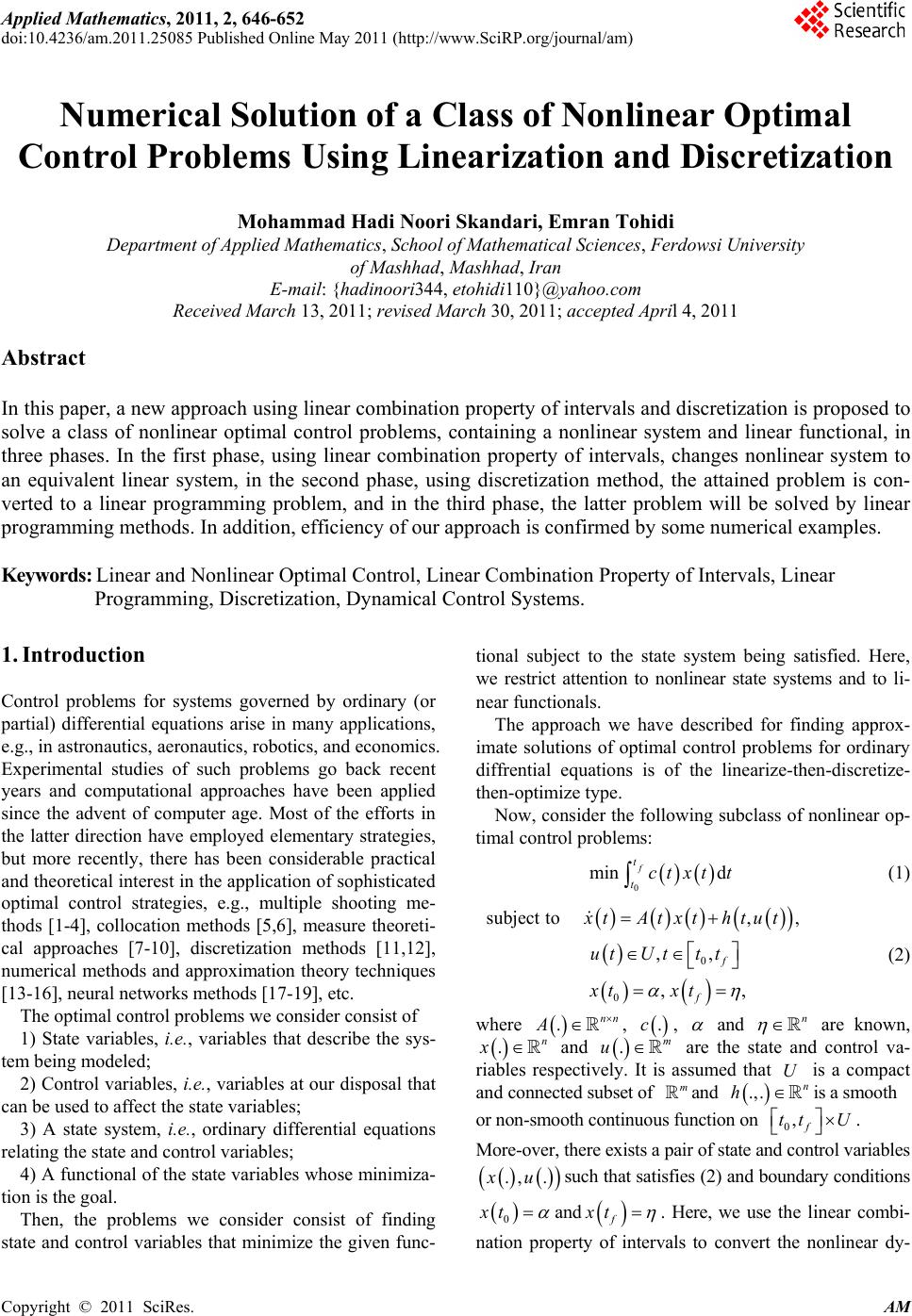 Applied Mathematics, 2011, 2, 646-652 doi:10.4236/am.2011.25085 Published Online May 2011 (http :/ /www.SciRP.org/journal/am) Copyright © 2011 SciRes. AM Numerical Solution of a Class of Nonlinear Optimal Control Problems Using Linearization and Dis cretization Mohammad Hadi Noori Skandari, Emran Tohidi Department of Applied Mathematics, School of Mathematical Sciences, Ferdowsi University of Mashhad, Mashhad, Iran E-mail: {hadinoori344, etohidi110}@yahoo.com Received March 13, 2011; revised March 30, 2011; accepted Ap ril 4, 2011 Abstract In this paper, a new approach using linear combination property of intervals and discretization is proposed to solve a class of nonlinear optimal control problems, containing a nonlinear system and linear functional, in three phases. In the first phase, using linear combination property of intervals, changes nonlinear system to an equivalent linear system, in the second phase, using discretization method, the attained problem is con- verted to a linear programming problem, and in the third phase, the latter problem will be solved by linear programming methods. In addition, efficiency of our approach is confirmed by some numerical examples. Keywords: Linear and Nonlinear Optimal Control, Linear Combination Property of Intervals, Linear Programming, Discretization, Dynamical Control Systems. 1. Introduction Control problems for systems governed by ordinary (or partial) differential equations arise in many applications, e.g., in astronautics, aeronau tics, robotics, and economics. Experimental studies of such problems go back recent years and computational approaches have been applied since the advent of computer age. Most of the efforts in the latter direction have employed elementary strategies, but more recently, there has been considerable practical and theoretical interest in the application of sophisticated optimal control strategies, e.g., multiple shooting me- thods [1-4], collocation methods [5,6], measure theoreti- cal approaches [7-10], discretization methods [11,12], numerical methods and approximation theory techniques [13-16], neural networks methods [ 17-19], etc. The optimal control problems we consider consist of 1) State variables, i.e., variables that describe the sys- tem being modeled; 2) Control variables, i.e., variables at our disposal that can be used to affect the state variables; 3) A state system, i.e., ordinary differential equations relating the state and control variables; 4) A functional of the state variables whose minimiza- tion is the goal. Then, the problems we consider consist of finding state and control variables that minimize the given func- tional subject to the state system being satisfied. Here, we restrict attention to nonlinear state systems and to li- near functionals. The approach we have described for finding approx- imate solutions of optimal control problems for ordinary diffrential equations is of the linearize-then-discre tize- then-optimize type. Now, consider th e following subclass of nonlinear op- timal control problems: (1) ( )( )( )( ) ( ) ( ) ( ) ( ) 0 0 subject to,, ,, ,, f f xtAtxt htut utUtt t xt xt αη = + ∈∈ = = (2) where , , and are known, and are the state and control va- riables respectively. It is assumed that is a compact and connected subset of and is a smooth or non-smooth continuous func tion on . More-over, there exists a pair of state and control variables such that satisfies (2) and boundary conditions and . Here, we use the linear co mbi- nation property of intervals to convert the nonlinear dy- 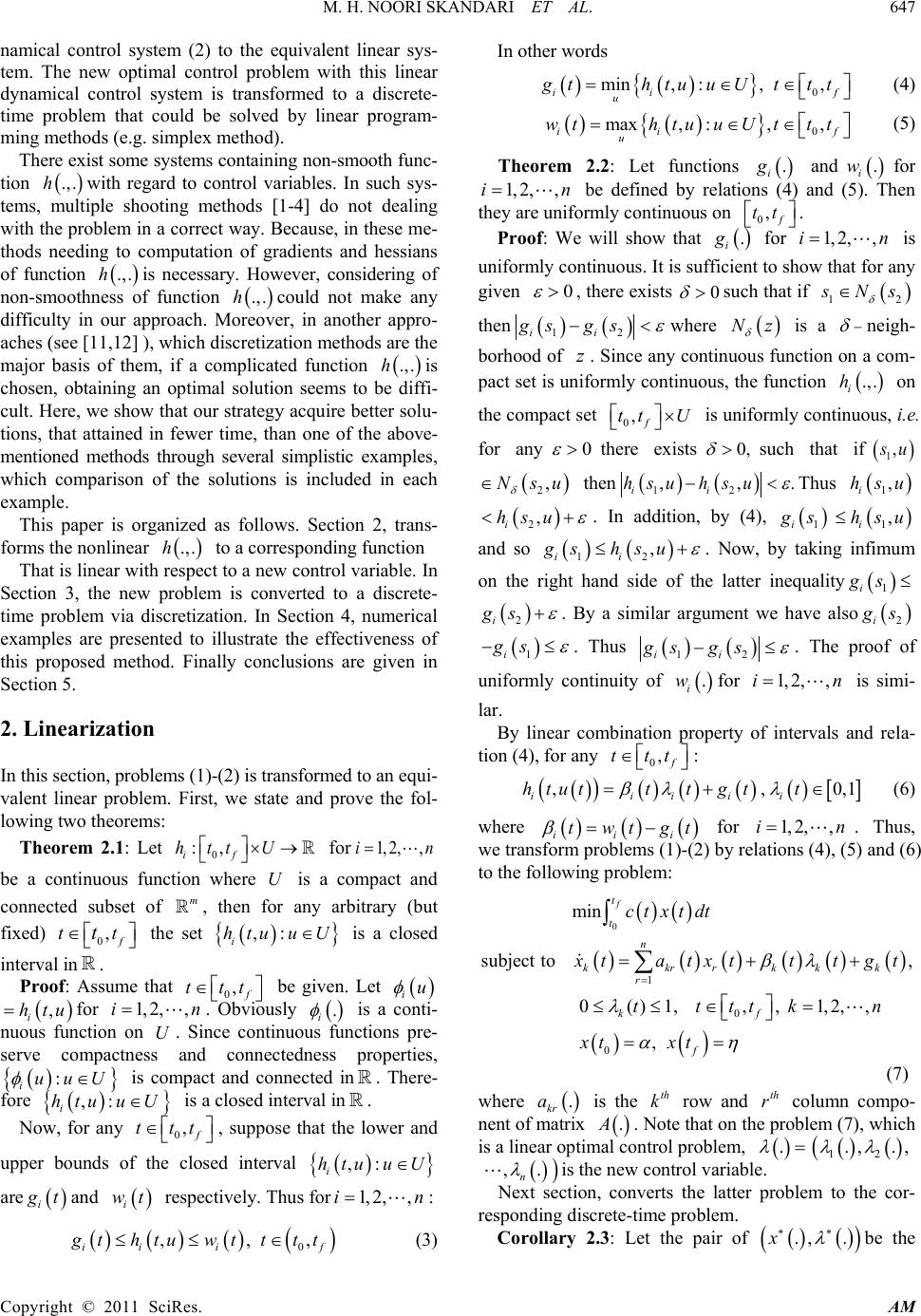 M. H. NOORI SKANDARI ET AL. Copyright © 2011 SciRes. AM namical control system (2) to the equivalent linear sys- tem. The new optimal control problem with this linear dynamical control system is transformed to a discrete- time problem that could be solved by linear program- ming m e t hods (e .g. simplex met hod ) . There exist some systems containing non-smooth func- tion with regard to control variables. In such sys- tems, multiple shooting methods [1-4] do not dealing with the problem in a correct way. Because, in these me- thods needing to computation of gradients and hessians of function is necessary. However, considering of non-smoothness of function could not make any difficulty in our approach. Moreover, in another appro- aches (see [11,12] ), which discretization methods are the major basis of them, if a complicated function is chosen, obtaining an optimal solution seems to be diffi- cult. Here, we show that our strategy acquire better solu- tions, that attained in fewer time, than one of the above- mentioned methods through several simplistic examples, which comparison of the solutions is included in each example. This paper is organized as follows. Section 2, trans- forms the nonlinear to a corresponding function That is linear with respect to a new control variable. In Section 3, the new problem is converted to a discrete- time problem via discretization. In Section 4, numerical examples are presented to illustrate the effectiveness of this proposed method. Finally conclusions are given in Section 5. 2. Linearization In this section, problems (1)-(2) is transformed to an equi- valent linear problem. First, we state and prove the fol- lowing two theorems: Theorem 2.1: Let for be a continuous function where is a compact and connected subset of , then for any arbitrary (but fixed) the set is a closed interval in . Proof: Assume that be given. Let for . Obviously is a conti- nuous function on . Since continuous functions pre- serve compactness and connectedness properties, is compact and connected in . There- fore is a closed interval in . Now, for any , suppose that the lower and upper bounds of the closed interval are and respec tively. Th us f or : ( )()( ) ( ) 0 , ,, ii if gth tuw tttt≤≤ ∈ (3) In other w ords ( )() { } 0 min, :,, ii f u gth tuuUtt t = ∈∈ (4) ( )() { } 0 max, :,, ii f u w th tuuUttt = ∈∈ (5) Theorem 2.2: Let functions and for be defined by relations (4) and (5). Then they are uniformly co ntinuous on . Proof: We will show that for is uniformly continuous. It is sufficient to show that for any given , th ere exists such that if then where is a neigh- borhood of . Since any continuous function on a com- pact set is uniformly continuous, the function on the compact set is uniformly continuous, i.e. for any there exists such that if then Thus . In addition, by (4), and so . Now, by taking infimum on the right hand side of the latter inequality . By a similar argument we have also . Thus . The proof of uniformly continuity of for is simi- lar. By linear combination property of intervals and rela- tion (4), for a n y : ( ) ( ) ( )( )( )( ) [ ] ,, 0,1 iiiii h tutttgtt βλ λ =+∈ (6) where for . Thus, we transform problems (1)-(2) by relations (4), (5) and (6) to the fol l owing pro bl e m: ( )() ( )( )( )( )( )( ) ( ) ( ) 0 1 0 0 min subject to, 0()1,,,1, 2,, , f t t n kkr rkkk r kf f ctxtdt xtatxtttgt tt ttkn xt xt βλ λ αη = = ++ ≤ ≤∈= = = ∫ ∑ (7) where is the row and column compo- nent of matrix . Note that on the problem (7), which is a linear optimal control problem, is the new co ntrol variable. Next section, converts the latter problem to the cor- responding discrete-time problem. Corollary 2.3: Let the pair of be the 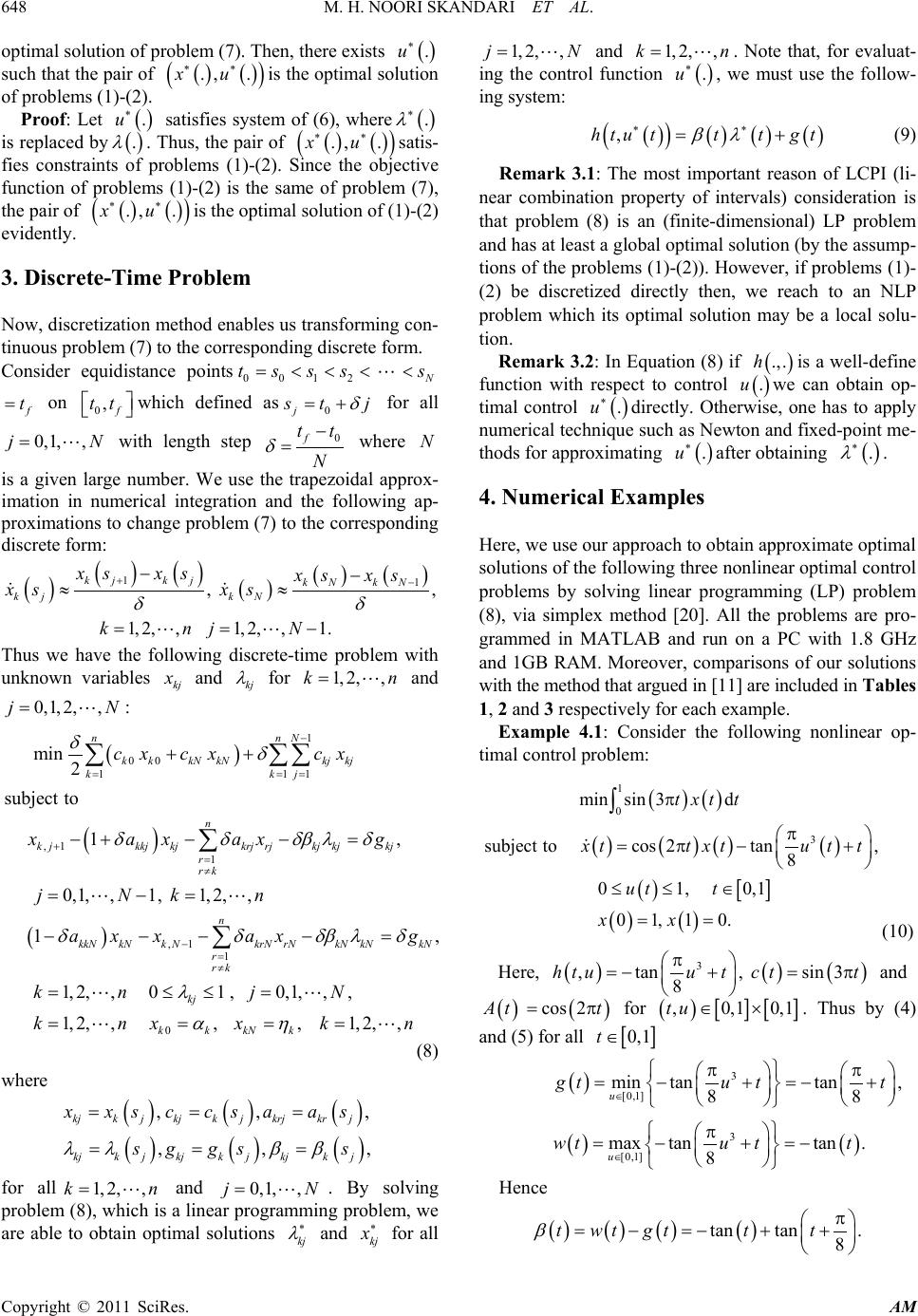 M. H. NOORI SKANDARI ET AL. Copyright © 2011 SciRes. AM optimal solution of problem (7). Then, there exists such that the pair of is the optimal solution of problems (1)-(2). Proof: Let satisfies system of (6), where is replaced by . Thus, the pair of satis- fies constraints of problems (1)-(2). Since the objective function of problems (1)-(2) is the same of problem (7), the pair of is the optimal solution of (1)-(2) evidently. 3. Discrete-Time Problem Now, discretization method enables us transforming con- tinuous problem (7) to the corresponding discrete form. Consider equidistance points on which defined as for all with length step where is a given large number. We use the trapezoidal approx- imation in numerical integration and the following ap- proximations to change problem (7) to the corresponding discrete form: ( )()() ( )()() 11 ,, 1, 2,,1, 2,,1. kj kjkN kN kj kN xs xsxs xs xs xs k nj N δδ +− −− ≈≈ == − Thus we have the following discrete-time problem with unknown variables and for and : ( ) ( ) ( ) 1 00 1 11 ,1 1 ,1 1 min 2 subject to 1, 0,1, ,1,1,2, , 1, 1,2, ,01,0,1, , , 1, n nN kkkNkNkj kj k kj n k jkkjkjkrjrjkjkjkj r rk n kkNkNk NkrNrNkNkNkN r rk kj c xcxcx xa xaxg j Nk n a xxaxg kn jN k δδ δδδβλδ δδδβλδ λ − == = += ≠ −= ≠ ++ −+−− = = −= −−−−= =≤≤ = = ∑ ∑∑ ∑ ∑ 0 2, ,,,1,2, , kk kNk nx xk n αη == = (8) where ( )( )( ) ( )( )( ) ,, , ,,, kjk jkjk jkrjkrj kjkjkjk jkjk j xxsccsaas s ggss λλ ββ = == = == for all and . By solving problem (8), which is a linear programming problem, we are able to obtain optimal solutions and for all and . Note that, for evaluat- ing the control function , we must use the follow- ing system: ( ) ( ) ( )( )( ) ,htu tttgt βλ ∗∗ = + (9) Remark 3.1: The most important reason of LCPI (li- near combination property of intervals) consideration is that problem (8) is an (finite-dimensional) LP problem and has at least a global optimal solution (by the assump- tions of the problems (1)-(2)). However , if problems (1)- (2) be discretized directly then, we reach to an NLP problem which its optimal solution may be a local solu- tion. Remark 3.2: In Equ ation (8) if is a well-define function with respect to control we can obtain op- timal control directly. Otherwise, one has to apply numerical technique such as Newton and fixed-point me- thods for approxi mating after obta ining . 4. Numerical Examples Here, we use our approach to obtain approximate optimal solutions of the following three nonlinear optimal control problems by solving linear programming (LP) problem (8), via simplex method [20]. All the problems are pro- grammed in MATLAB and run on a PC with 1.8 GHz and 1GB RAM. Moreover, comparisons of our solutions with the method that argued in [11] are included in Tables 1, 2 and 3 respectively for each example. Example 4.1: Consider the following nonlinear op- timal control problem: ()() ( )()()( ) ( ) [ ] ()( ) 1 0 3 minsin 3d subject tocos2tan, 8 01, 0,1 01, 10. txt t xttxtu tt ut t xx π π =π− + ≤≤ ∈ = = ∫ (10) Here, ( )( )() 3 ,tan,sin3 8 htuu t ctt π =− +=π and for . Thus by (4) and (5) for a ll ( ) 3 [0,1] min tantan, 88 u gtu tt ∈ π π = −+=−+ ( )( ) 3 [0,1] maxtantan . 8 u wtu tt ∈ π = −+=− Hence ( )( )( )( ) tan tan. 8 twt gttt β π =−=−+ + 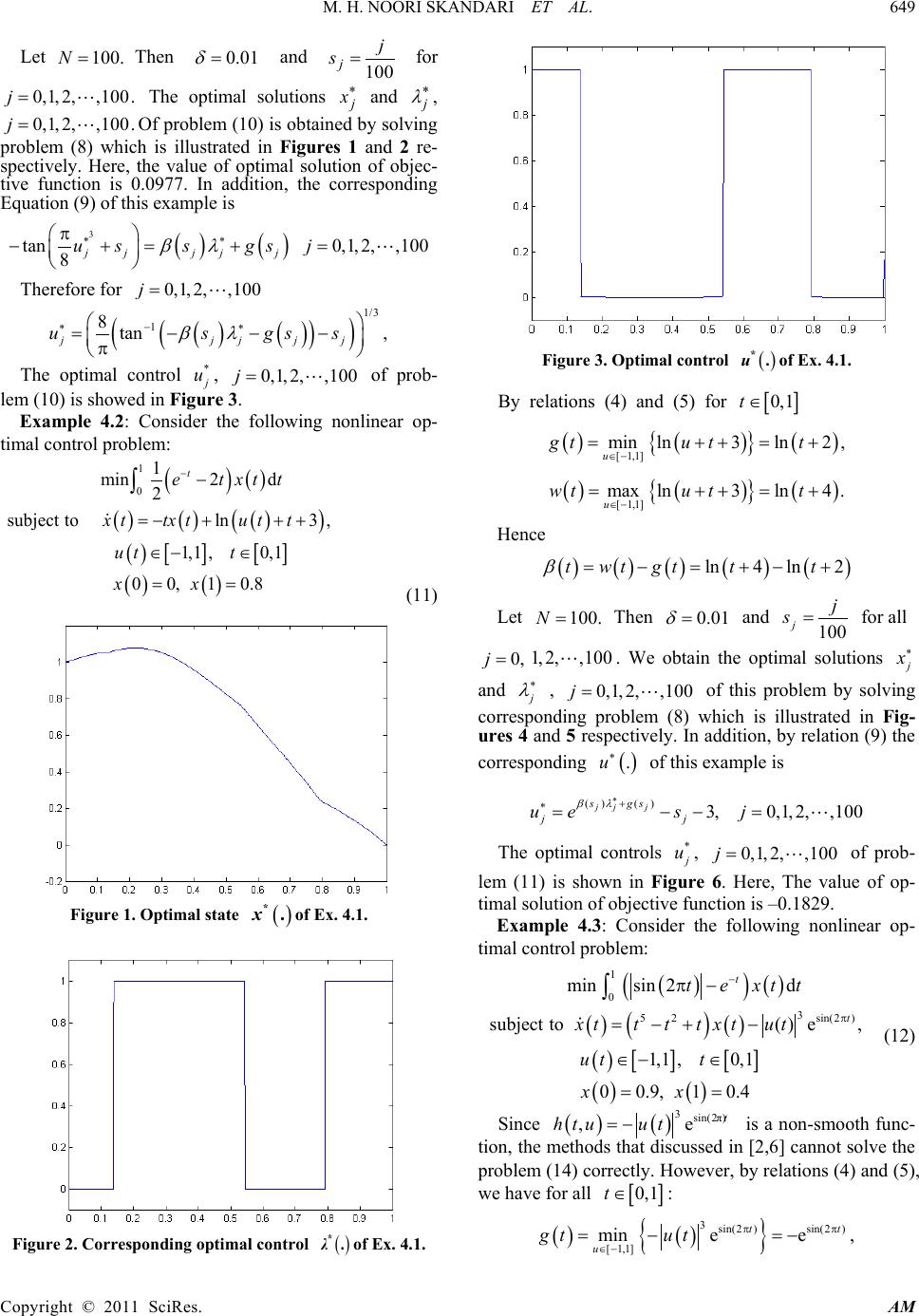 M. H. NOORI SKANDARI ET AL. Copyright © 2011 SciRes. AM Let Then and for The optimal solutions and , Of problem (10) is obtained by solving problem (8) which is illustrated in Figures 1 and 2 re- spectively. Here, the value of optimal solution of objec- tive function is 0.0977. In addition, the corresponding Equation (9) of this example is ( )( ) 3 tan0,1,2, ,100 8 j jjjj u ssgsj βλ ∗∗ π −+= += Theref ore for ( )( ) ( ) ( ) 1/3 1 8tan , jjjj j usgs s βλ ∗− ∗ =− −− π The optimal control , of prob- lem (10) is showed in F igure 3. Example 4.2: Consider the following nonlinear op- timal control problem: ( ) ( ) ( )()( ) ( ) ( ) [][] ()( ) 1 0 1 min2 d 2 subject toln3, 1,1,0,1 00,1 0.8 t etxtt xttxtut t ut t xx − − =− +++ ∈− ∈ = = ∫ (11) Figure 1. Optimal state of Ex. 4.1. Figure 2. Corresponding optimal control of Ex. 4.1. Figure 3. Optimal control of Ex. 4.1. By relations (4) and (5) for ( )() { } ( ) [ 1,1] minln3 ln 2, u gtu tt ∈− =++ =+ ( )() { } ( ) [ 1,1] maxln3ln 4. u wtu tt ∈− =++=+ Hence ( )( )( )() () ln 4ln 2twt gttt β =−=+− + Let Then and 100 j j s= for all . We obtain the optimal solutions and , of this problem by solving corresponding problem (8) which is illustrated in Fig- ures 4 and 5 respectively. In addition, by relation (9) the corresponding of this example is () () 3,0,1,2, ,100 jj j s gs jj ues j βλ ∗ + ∗ =−− = The optimal controls , of prob- lem (11) is shown in Figure 6. Here, The value of op- timal solution of objective function is –0.1829. Example 4.3: Consider the following nonlinear op- timal control problem: ( ) ( ) ( ) ( ) ( ) ( ) ( ) [][ ] ()( ) 1 0 3 52sin(2 ) minsin 2d subject to()e, 1,1 ,0,1 00.9,10.4 t t text t xtt ttxtut ut t xx − π π− = −+− ∈− ∈ = = ∫ (12) Since ()( ) 3sin(2π) ,e t htu ut= − is a non-smooth func- tion, the methods that discussed in [2,6] cannot solve the problem (14) correctly. However, by relations (4) and (5), we have for all : ( )( ) { } 3sin(2 )sin(2 ) [ 1,1] minee, tt u gt ut ππ ∈− =−=− 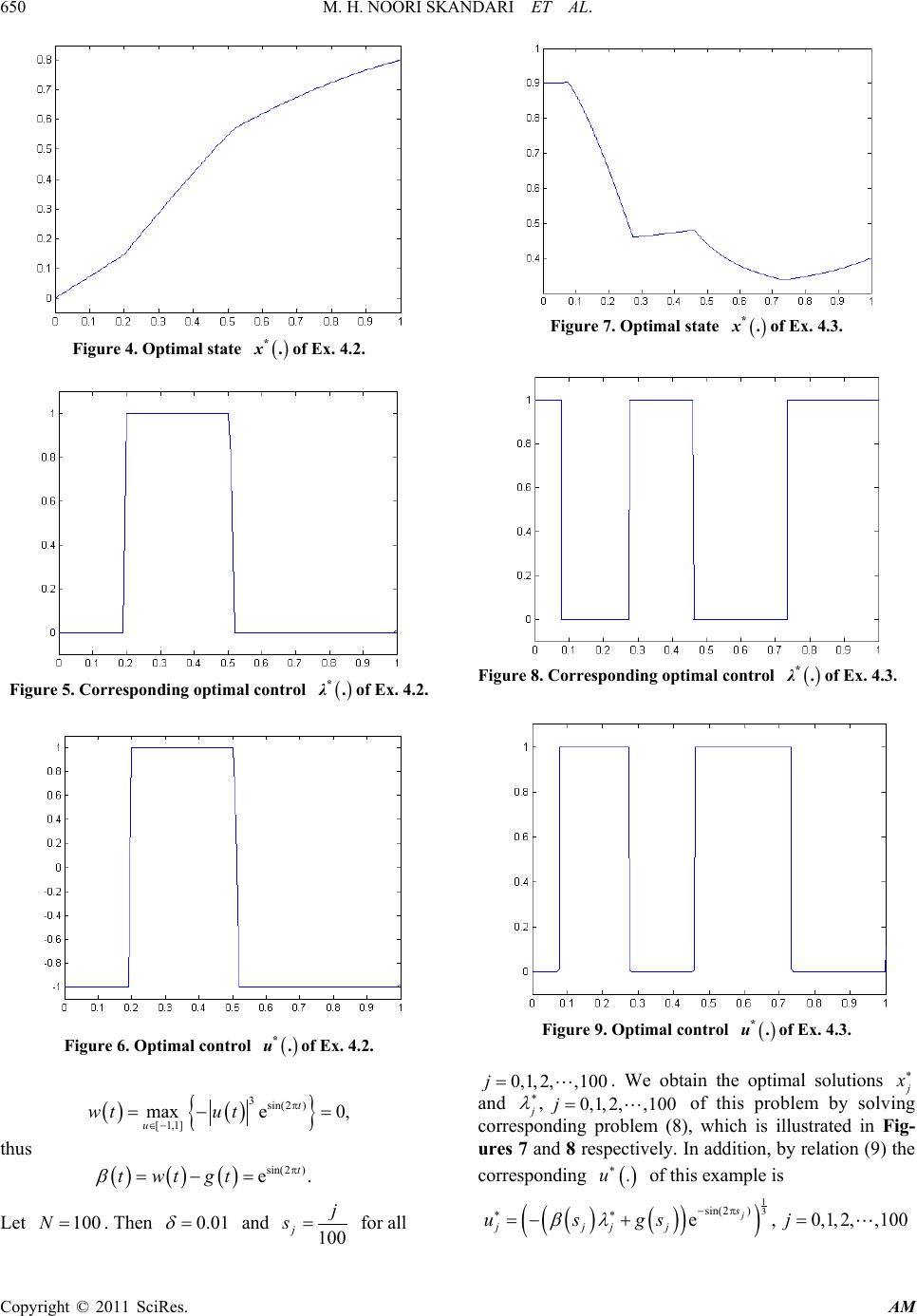 M. H. NOORI SKANDARI ET AL. Copyright © 2011 SciRes. AM Figure 4. Optimal state of Ex. 4.2. Figure 5. Corresponding optimal control of Ex. 4.2. Figure 6. Optimal control of Ex. 4.2. ( )() { } 3sin(2 ) [ 1,1] maxe 0, t u wt ut π ∈− =−= thus ( )( )( ) sin(2 ) e. t twtgt β π =−= Let . Then and for all Figure 7. Optimal state of Ex. 4.3. Figure 8. Corresponding optimal control of Ex. 4.3. Figure 9. Optimal control of Ex. 4.3. . We obtain the optimal solutions and of this problem by solving corresponding problem (8), which is illustrated in Fig- ures 7 and 8 respectively. In addition, by relation (9) the corresponding of this example is ( )() ( ) ( ) 1 3 sin(2 ) e,0,1,2, ,100 j s jjjj usgsj βλ −π ∗∗ =−+ = 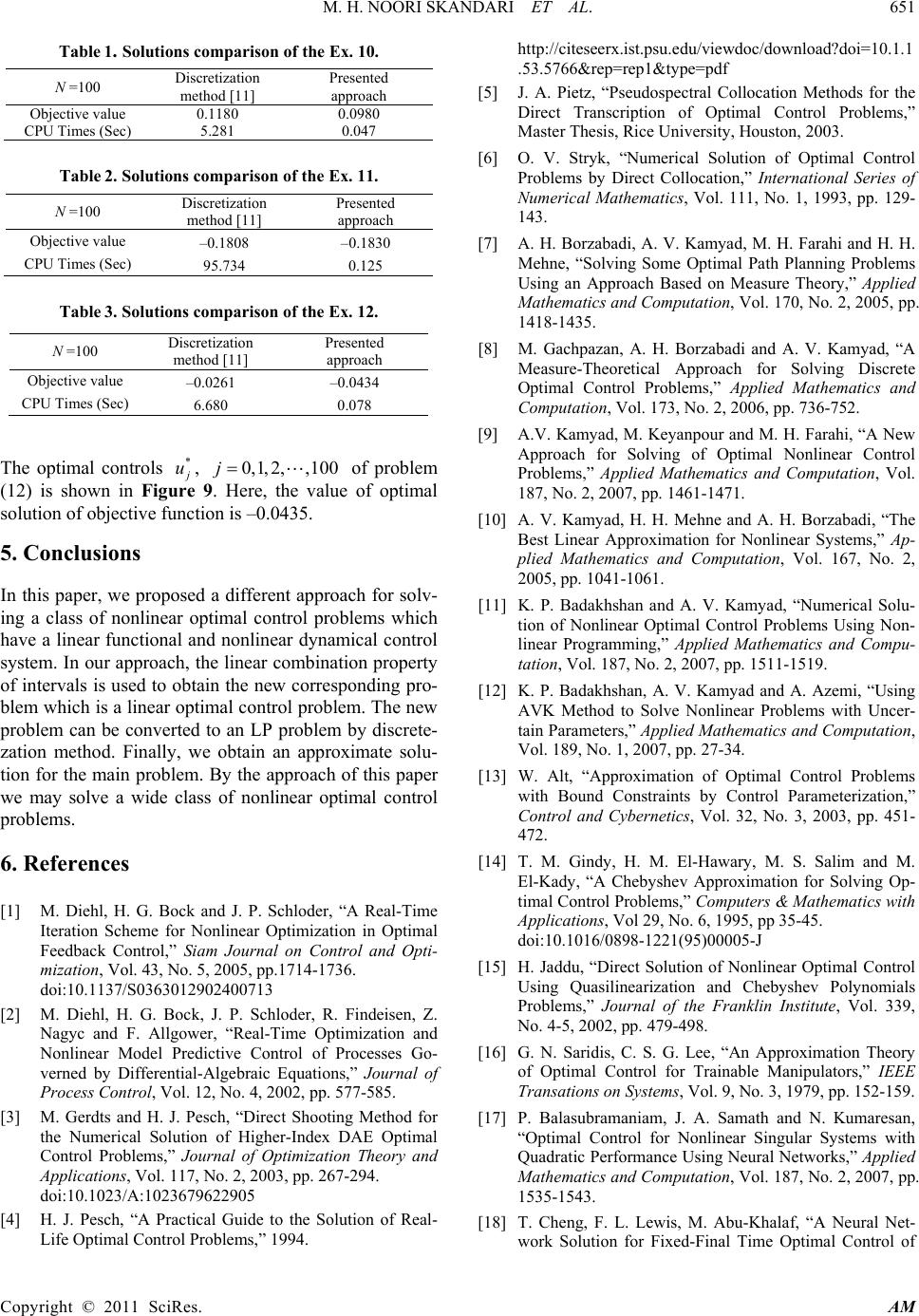 M. H. NOORI SKANDARI ET AL. Copyright © 2011 SciRes. AM Table 1. Solutions comparison of the Ex. 10. N =100 method [11] approach Table 2. Solutions comparison of the Ex. 11. N =100 Discretization method [11] Objective value –0.1808 –0.1830 CPU Times (Sec) 95.734 0.125 Table 3. Solutions comparison of the Ex. 12. N =100 Discretization method [11] Presented ap p ro ach Objective value –0.0261 –0.0434 CPU Times (Sec) 6.680 0.078 The optimal controls , of problem (12) is shown in Figure 9. Here, the value of optimal solution of objective function is –0.0435. 5. Conclusions In this paper, we proposed a different approach for solv- ing a class of nonlinear optimal control problems which have a linear functional and nonlinear dynamical control system. In our approach, the linear combination property of intervals is used to obtain the new corresponding pro- ble m wh ich is a linear optimal control problem. The new problem can be converted to an LP problem by discrete- zation method. Finally, we obtain an approximate solu- tion for the main problem. By the approach of this paper we may solve a wide class of nonlinear optimal control problems. 6. References [1] M. Diehl, H. G. Bock and J. P. Schloder, “A Real-Time Iteration Scheme for Nonlinear Optimization in Optimal Feedback Control,” Siam Journal on Control and Opti- mization, Vol. 43, No. 5, 2005, pp.1714-1736. doi:10.1137/S0363012902400713 [2] M. Diehl, H. G. Bock, J. P. Schloder, R. Findeisen, Z. Nagy c and F. Allgower, “Real-Time Optimization and Nonlinear Model Predictive Control of Processes Go- verned by Differential-Algebraic Equations,” Journal of Process Control, Vol. 12, No. 4, 2002, pp. 577-585. [3] M. Gerdts and H. J. Pesch, “Direct Shooting Method for the Numerical Solution of Higher-Index DAE Optimal Control Problems,” Journal of Optimization Theory and Applications, Vol. 117, No. 2, 2003, pp. 267-294. doi:10.1023/A:1023679622905 [4] H. J. Pesch, “A Practical Guide to the Solution of Real- Life Optimal Control Problems,” 1994. http://citeseerx.ist.psu.edu/viewdoc/download?doi=10.1.1 .53.5766&rep=rep1&type=pdf [5] J. A. Pietz, “Pseudospectral Collocation Methods for the Direct Transcription of Optimal Control Problems,” Master Thesis, Ric e University, Houston, 2003. [6] O. V. Stryk, “Numerical Solution of Optimal Control Problems by Direct Collocation,” International Series of Numerical Mathematics, Vol. 111, No. 1, 1993, pp. 129- 143. [7] A. H. Borzabadi, A. V. Kamyad, M. H. Farahi and H. H. Mehne, “Solving Some Optimal Path Planning Problems Using an Approach Based on Measure Theory,” Applied Mathematics and Computation, Vol. 170, N o. 2, 2005, pp. 1418-1435. [8] M. Gachpazan, A. H. Borzabadi and A. V. Kamyad, “A Measure-Theoretical Approach for Solving Discrete Optimal Control Problems,” Applied Mathematics and Computation, Vol. 173, No. 2, 2006, pp. 736-752. [9] A.V. Kamyad, M. Keyanpour and M. H. Farahi, “A New Approach for Solving of Optimal Nonlinear Control Problems,” Applied Mathematics and Computation, Vol. 187, No. 2, 2007, pp. 1461-1471. [10] A. V. Kamyad, H. H. Mehne and A. H. Borzabadi, “The Best Linear Approximation for Nonlinear Systems,” Ap- plied Mathematics and Computation, Vol. 167, No. 2, 2005, pp. 1041-1061. [11] K. P. Badakhshan and A. V. Kamyad, “Numerical Solu- tion of Nonlinear Optimal Control Problems Using Non- linear Programming,” Applied Mathematics and Compu- tation, Vol. 187, No. 2, 2007, pp. 1511-1519. [12] K. P. Badakhshan, A. V. Kamyad and A. Azemi, “Using AVK Method to Solve Nonlinear Problems with Uncer- tain Parameters,” Applied Mathematics and Computation, Vol. 189, No. 1, 2007, pp. 27-34. [13] W. Alt, “Approximation of Optimal Control Problems with Bound Constraints by Control Parameterization,” Control and Cybernetics, Vol. 32, No. 3, 2003, pp. 451- 472. [14] T. M. Gindy, H. M. El-Hawary, M. S. Salim and M. El-Kady, “A Chebyshev Approximation for Solving Op- timal Control Problems,” Computers & Mathematics with Applications, Vol 29, No. 6, 1995, pp 35-45. doi:10.1016/0898-1221(95)00005-J [15] H. Jaddu, “Direct Solution of Nonlinear Optimal Control Using Quasilinearization and Chebyshev Polynomials Problems,” Journal of the Franklin Institute, Vol. 339, No. 4-5, 2002, pp. 479-498. [16] G. N. Saridis, C. S. G. Lee, “An Approximation Theory of Optimal Control for Trainable Manipulators,” IEEE Transations on Systems, Vol. 9, No. 3, 1979, pp. 152-159. [17] P. Balasubramaniam, J. A. Samath and N. Kumaresan, “Optimal Control for Nonlinear Singular Systems with Quadratic Performance Using Neural Networks,” Applied Mathematics and Computation, Vol. 187, No. 2, 2007, pp. 1535-1543. [18] T. Cheng, F. L. Lewis, M. Abu-Khalaf, “A Neural Net- work Solution for Fixed-Final Time Optimal Control of  M. H. NOORI SKANDARI ET AL. Copyright © 2011 SciRes. AM Nonlinear Systems,” Automatica, Vol. 43, No. 3, 2007, pp. 482-490. [19] P. V. Medagam and F. Pourboghrat, “Optimal Control of Nonlinear Systems Using RBF Neural Network and Adaptive Extended Kalman Filter,” Proceedings of American Control Conference Hyatt Regency Riverfront, St. Louis, 10-12 June 2009, pp. 355-360. [20] D. Luenberger, “Linear and Nonlinear Programming,” Kluwer Academic Publishers, Norwell, 1984.
|